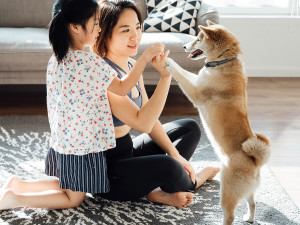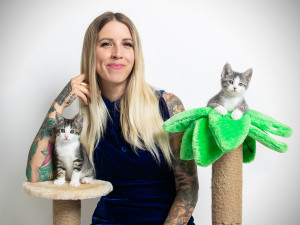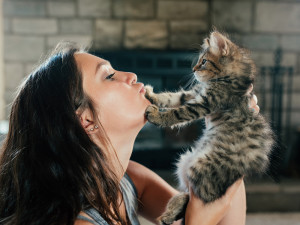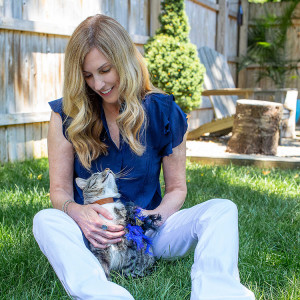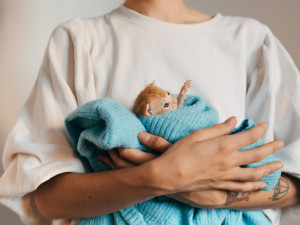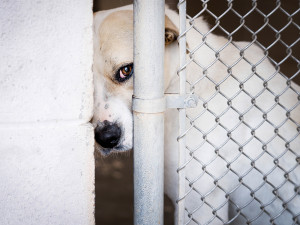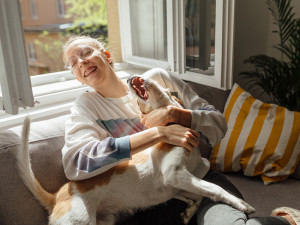A Guide to Fostering Pets When You Have Kids
Advice from parents who truly do it all.
It’s the question that sparked the debate of a generation (or a debate, anyway): kids or pets? We’ve been bombarded with headlines that read, “One Big Reason Millennials Are Buying Homes? For Their Dogsopens in new tab” or “Millennials Love Pets More Than Siblings, Partnersopens in new tab.” But for people who play the parenting role to human and dog or cat children, the equation gets a little more complicated.
Of course we love our pets, but fostering pets is a completely different undertaking. How do we keep our human kids safe when bringing new animals into the house — especially when those animals have unknown histories? And how do we keep scared, anxious, incoming foster pets safe from those grubby, sticky (it’s just a universal toddler truth) little hands?
I spoke with four foster families from Columbia Second Chanceopens in new tab — where I am also a pet foster and volunteer — about their experiences with fostering and parenting (or grandparenting). While Second Chance has graciously provided me with three permanent pets, I’m not a parent to a human child myself. In fact, my house full of animals often has me wondering how millennial moms and dads do it all. (I’m guessing they listen to lots of motivational advice from Brené Brown?) So, here’s the advice parents who foster pets want you to know about balancing the children in your life with the foster pets in your home.
Communication is Key
When she began fostering in January of 2020, Melissa Baumann knew she wanted to involve her grandkids in the experience. She set up a dedicated foster room and would have supervised play sessions with her six-year-old grandson and her foster kittens. “As I saw that he did really well with the kittens, he was allowed to go into the room by himself,” Baumann says. Her grandson would take his cars and monster trucks into the room and let the kittens share his toys.
How much do you spend on your pet per year?
“I think fostering is very beneficial to kids,” she adds. “They get to understand the concept of helping animals at the lowest point of their lives. Their understanding that some of the kittens are very sick and need extra special care is amazing to me.”
Baumann was shocked at her grandson’s composure when their first kittens went to their forever homes, but she’d previously explained to him that someday these kittens would live somewhere else. Her best tip for new fosters with children: communicate and provide explanations the kids will understand: “Being honest upfront that [the animals] will leave someday is the best way to help kids prepare, so they don’t misunderstand that the pets will be there forever.”
Slow and Steady
Giulia Hall, executive director of Columbia Second Chance, fostered animals for six years before becoming a parent. She says the balance between fostering and caring for her kids was a challenge at first, but their family has learned how to welcome in new foster pets with minimal hurdles. “It can seem overwhelming when you consider taking on another responsibility, but just take it slow. It is so rewarding and so good for the children; it’s absolutely worth it,” she says.
Before she became a mom, Hall often took in tough cases and high-risk dogs, but since her son was born, she’s much more cautious about the dogs she brings into her home. “I’m especially careful to make sure they’re friendly, but seeing how my son interacts with new dogs and how gentle he is becoming and how he adapts to new dogs is amazing,” she says.
Even experienced foster parents need time to adjust their routines to accommodate a new little one. Training becomes double the work, between teaching toddlers “gentle petting” and helping pets adjust to the tiny balls of human energy bouncing around their new foster homes. “The hardest thing is just being constantly vigilant for the safety of my son and the dog,” Hall shares. “But it teaches kids compassion and responsibility and exposes animals to children, noise, and clutter — making for a more well-rounded pet.”
Prepare, Prepare, Prepare
Before they started fostering in 2019, Rebecca Atkins’ family read “Kitten Lady” Hannah Shaw’s Big Book of Little Kittens (and binge-watched tons of videosopens in new tab online). Their research helped them explain the purpose of fostering and set up expectations ahead of time. “We had a strong ‘we will not adopt’ policy because we didn’t want the kids begging each time we had new fosters,” Atkins says. “We were very clear that our role was to get them ready for their forever home.”
Before the Adkins started fostering, their three-and six-year-old kids had never been exposed to kittens or had to care for sick animals. The first few litters came with the challenges of setting boundaries around handling the kittens and expectations for saying goodbye, but fostering has been beneficial to their kids in many ways. “We practice math when weighing kittens and calculating their growth,” Atkins explains. “We practice our writing when it’s time to write bios for the [adoption] website. Last year we named all our kittens after plants and flowers to learn about botany.” They read about animal enrichment, make cat houses and toys, and enjoy “kitten therapy” as a family on their tough days.
Those tough days have included losing a couple of kittens to illness. “Saying goodbye after trying your best to nurse them back to health is hard for an adult, and it’s even harder with little kids,” Atkins says. “Luckily, we’ve only had to experience this twice, and each time we’ve taken a little break, and I ask the kids if they want to continue. And the answer is a quick yes.”
Only Take On What You Can Handle
Lara Landrum’s daughter was eight years old when her family started fostering cats. “If you are new to it, start small,” she advises. “Adult cats generally are in [their] foster homes for just a couple weeks. That is a great way to test things out.” She also recommends starting with just one foster at once: “Kittens really need friends and are often with you for months. It’s good to know how your family handles foster additions before committing to that.”
Landrum advises new fosters to “only take on what you can” and cautions that some fosters come with health issues or inevitably get sick once you bring them home. “We don’t always know much about their histories. There may be some late nights. Tiny kittens are really fun, but really fragile,” she says. During their five yeras of fostering, Landrun’s family has experienced the death of two kittens. “We did everything we could for them, but it was hard. I never assume there won’t be some really sad moments,” she shares.
Despite the sad moments, Landrum and her family still find immense joy in fostering. Her daughter has learned a lot about caring for young kittens and protecting community cats, and even educates others who are interested in learning about her experiences. “I think it is a wonderful experience,” Landrum says. “Tending [to] another being requires the cultivation of love and gentleness. I think it really aids a child in developing their observation skills and empathy…Fostering is really fun, and we find ourselves smiling and laughing a lot.”
Her biggest piece of advice for new fosters: “It’s really important to know your capacity and honor it. Kids want to help, they approach things with enthusiasm, but at the end of the day, all the work is the adult’s responsibility.”
Takeaway Tips
Be ready for messes. If you are skilled at child-proofing, you are probably skilled at kitten-proofing.
Be prepared to make adjustments to your setup. Pets and kids are smart; that baby gate may not be enough to keep them apart — especially at snack time.
Learn together. If you’re a first-time foster, don’t be afraid to let your kids see your mistakes and move on as a family.
Quarantine is key: Ensure your new foster pets are parasite-free before introducing them to your children.
Don’t rush it. If you’re eager to get back to fostering after having children, don’t force it. Take time to find a foster pet who fits into your new family — it’ll be better for the pet and your kids.
Set expectations. Make sure your kids know the purpose of fostering and that these pets won’t be in your home forever.

